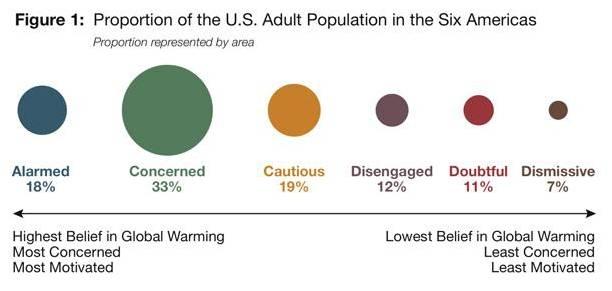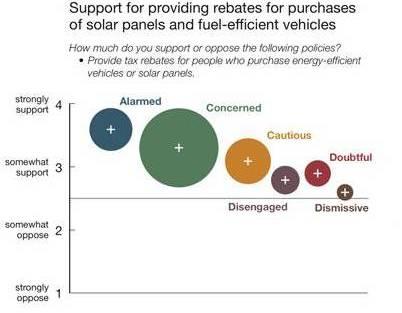Confusion among the public about climate change is plentiful. People use varying terminology to discuss climate change and have varying thoughts about the extent to which climate change exists, why climate change is occurring, and how problematic climate change is. Psychologists and communication experts have studied public perceptions about climate change. This article summarizes their findings and suggests elements that natural resource specialists might find most useful.
What Do People Call the Warming of the Earth’s Atmosphere?
Experts use the terms climate change and global warming to describe the warming of the Earth’s atmosphere due to the input of additional greenhouse gases. For some, the term climate change is more accurate, whereas others believe the term global warming better conveys the urgency of the issue (Villar and Krosnick 2010). Studies comparing public responses to these terms find that, on average, Americans and Europeans regard both terms equally as naming a serious problem. Several studies use only the term global warming because the authors believe it is less ambiguous or because they have explained to participants that global warming increases the world’s average temperature and, thereby, results in climate change (Leiserowitz et al. 2010a). However, the public uses the terms climate change and global warming interchangeably.
Do People Believe the Climate Is Changing?
Surveys of adults in the United States reveal differing beliefs about whether or the extent to which the climate is changing. The Six Americas studies (Maibach et al. 2009, Leiserowitz et al. 2010b) report on six categories of the American public that vary on how strongly they believe the Earth’s temperature is warming and what they are willing to do about it:
- Alarmed (18%)—are fully convinced of the seriousness of climate change and supportive of taking action to limit greenhouse gas use.
- Concerned (33%)—believe climate change is happening and intend to change behaviors to reduce greenhouse gas use but may not have implemented those changes in behavior yet.
- Cautious (19%)—believe global warming is a problem but are uncertain of whether it is occurring and, therefore, do not feel an urgency to make changes.
- Disengaged (12%)—do not know or have not thought much about global warming.
- Doubtful (11%)—are unsure about whether global warming is happening and believe that if it is happening, it is due to natural changes in the environment that will not cause harm for many decades; believe that America already is doing enough to address the issue.
- Dismissive (7%)—are convinced that climate change is not occurring and, therefore, that the issue does not warrant a public response.

Most research shows that a large majority of Americans believe global warming is occurring. The portion of the population that is doubtful or skeptical about global warming differs depending on which survey is referenced. For example, an online survey of 2,030 Americans in July 2010 found that 19% think global warming is not happening, 19% are not sure whether global warming is happening, and 37% could change their minds about whether global warming is (Leiserowitz et al. 2010a). According to the Six Americas surveys, between 7% and 16% of the population does not believe the climate is changing (Maibach et al. 2009, Leiserowitz et al. 2010b). When asked how sure they are that global warming is or is not happening, 34% of survey participants responded “somewhat sure,” “not at all sure,” or “don’t know” (Leiserowitz et al. 2010b). Survey reports differ because the questions vary. Some ask respondents about their certainty; others ask whether climate has changed or is changing. In some cases, questions are convoluted. When asked whether the world’s temperatures have been rising slowly over the last 100 years, 75% of Americans agreed that they have (Schwartz, 2010).
What Do People Think Causes Climate Change?
Between 50% and 75% of survey respondents believe human activities are causing global warming (Krosnick 2010, Leiserowitz et al. 2010a). However, little consensus exists among respondents about the factors contributing to global warming. For example, in a survey of Floridians who believe global warming is happening, 55% believe it is caused mainly by human activities, 32% believe it is caused by natural climate cycles, and 13% believe it is a combination of human activity and natural cycles (Leiserowitz and Broad 2008). Communicators believe that the public will be more likely to do something about climate change if they believe the change is caused by human activity.
Do People View Climate Change as a Problem?
In a national study, the majority of respondents (68%) indicated concern about impacts of climate change on people worldwide and on non-human nature (Leiserowitz 2006). However, when respondents in another survey were asked to prioritize domestic issues, climate change fell at the bottom of a list of 20 issues (Nisbet 2009). In Florida, 65% of respondents believe dangerous impacts will occur in their state in next 25 years, yet respondents are more likely to believe that global warming will affect plants, animals, and people in other countries more than themselves (Leiserowitz and Broad 2008). Even those who believe the climate is changing do not know whether the changes will affect them or do not believe the changes will affect them. Furthermore, they consider other issues more important right now.
What Knowledge Do People Have about Climate Change?
Studies reveal that the public is still confused about global warming and its causes (Bostrom et al. 1994). In the Six Americas studies, less than half of respondents (45%) understood that the greenhouse gas carbon dioxide traps heat from the Earth’s surface and only 25% had heard of coral bleaching or ocean acidification. Respondents recognize the limitations of their knowledge: 75% would like to know more, and 75% want schools to teach children about causes of, consequences of, and potential solutions to climate change (Leiserowitz et al. 2010a). Many people have limited and inaccurate understandings of climate change, but they are willing to learn more.
Do People Support Taking Action in Response to Climate Change?

While 76% of survey respondents favor government limitations on greenhouse gas emissions by businesses, even more favor encouraging a switch to more efficient cars (81%), appliances (80%), and homes (80%) (Krosnick 2010). Respondents in all categories of the Six Americas studies favor funding research for renewable energy and providing tax rebates for solar panel purchases and state that they are willing to make energy efficiency improvements at home (Leiserowitz et al. 2010b). There is public support for actions that conserve energy and invest in renewable energy.
What Factors Affect Public Perceptions about Climate Change?
The following factors make it challenging for people to understand and agree on the implications of climate change:
- Climate change is a slow process.
- Evidence of change is often far away or not obvious (Leiserowitz et al. 2010b).
- Natural climate cycles make it difficult to convince skeptics that humans are a contributing factor.
- Experience is a more powerful teacher than someone else’s data.
- The climate system is complex; it may not be possible to simplify the issue accurately.
- The issue is strongly affected by political and religious positions; knowledge is not the only predictor of beliefs; worry is not the only predictor of action.
- Information about contentious issues conveyed through mass media reinforces existing beliefs and does not change opinions.
What Does the Research Mean?
People have different psychological, cultural, and political reasons for their beliefs and actions regarding climate change. Methods for getting people to act in response to climate change can be based on the research findings described in this article.
Those who would like to encourage people to adopt new behaviors or to support policy changes should try to frame the issue of climate change with strategies that are already positively received. The concepts of energy conservation, reduced reliance on fossil fuels, and support for renewable energy sources are compatible with climate change mitigation activities.
Storylines enable people to interpret information and assimilate it into relevant mental models; moral obligation, thrift, job creation, and stewardship (Nisbet 2009) resonate with this issue.
Even among those who believe the climate is changing, many think impacts will be felt by others rather than themselves. Discussions of climate change should include descriptions of vicarious experience or opportunities for direct experience to convey risk more accurately and to generate appropriate levels of concern (Weber 2006, Leiserowitz et al. 2010b).
Empowering people to change their behaviors may be more likely through citizen science and social learning through participatory groups.
For More Information
Wojcik, D.J., M.C. Monroe, D.C. Adams, and R.C. Plate, 2014. Message in a bottleneck? Attitudes and perceptions of climate change in the Cooperative Extension Service in the Southeastern United States. Journal of Human Science and Extension 2(1): 51-70.
Contributor
Martha C. Monroe, University of Florida
Sources
Bostrom, A., Morgan, M. G., Fischhoff, B. & Read, D. 1994. What do people know about global climate change? 1. Mental models. Risk Analysis. 14(5): 959-970.
Krosnick, J. A. (2010) The climate majority. New York Times, June 8, 2010. http://nytimes.com/2010/06/09/opinion/09krosnick.
Krosnick J. A. (website) Large Majority of Amercians Support Government Solutions to Address Global Warming. https://woods.stanford.edu/research/public-opinion-research.
Leiserowitz, A., Smith, N. & Marlong, J.R. (2010) Americans’ Knowledge of Climate Change. Yale University, New Haven, CT: Yale Project on Climate Change Communication. http://environment.yale.edu/climate/files/ClimateChangeKnowledge2010.pdf
(L6) Leiserowitz, A., Maibach, E., Roser-Renouf, C. & Smith, N. (2010) Global Warming’s Six Americas, June 2010. Yale University and George Mason University, New Haven, CT: Yale Project on Climate Change. http://environment.yale.edu/climate/files/SixAmericasJune2010.pdf
Leiserowitz, A. & Broad, K. (2008) Florida: Public opinion on climate change. A Yale University / University of Miami / Columbia University Poll. New Haven, CT: Yale Project on Climate Change. http://environment.yale.edu/uploads/FloridaGlobalWarmingOpinion.pdf
Leiserowitz, A. (2006) Climate change risk perception and policy preferences: The role of affect, imagery, and values. Climatic Change. 77: 45-72.
Maibach, E., Roser-Renouf, C. & Leiserowitz, A. (2009). Global Warming’s Six Americas 2009: An audience segmentation analysis. Yale University, New Haven, CT: Yale Project on Climate Change. Available at: www.americanprogress.org/issues/2009/05/6americas.html
Nisbet, M. A. 2009. Communicating climate change: Why frames matter for public engagement. Environment. 51(2): 12-23.
O’Conner, R. E., Bord, R. J. & Fisher, A. 1999. Risk perceptions, general environmental beliefs, and willingness to address climate change. Risk Analysis. 19(3): 461-471.
Schwartz, M., 2010. Majority of Americans continue to believe that global warming is real. Summary of research reports by Jon Krosnick, and available at: http://climatepublicopinion.stanford.edu/sample-page/research/majority-o….
Villar, A. & Krosnick, J.A. (2010) Global warming vs. Climate change, taxes vs. prices: Does word choice matter? Climatic Change. DOI 10.1007/s10584-010-9882-x.
Weber, E. U. 2006. Experienced-based and description-based perceptions of long-term risk: Why global warming does not scare us (yet). Climatic Change. 77: 103-120.
